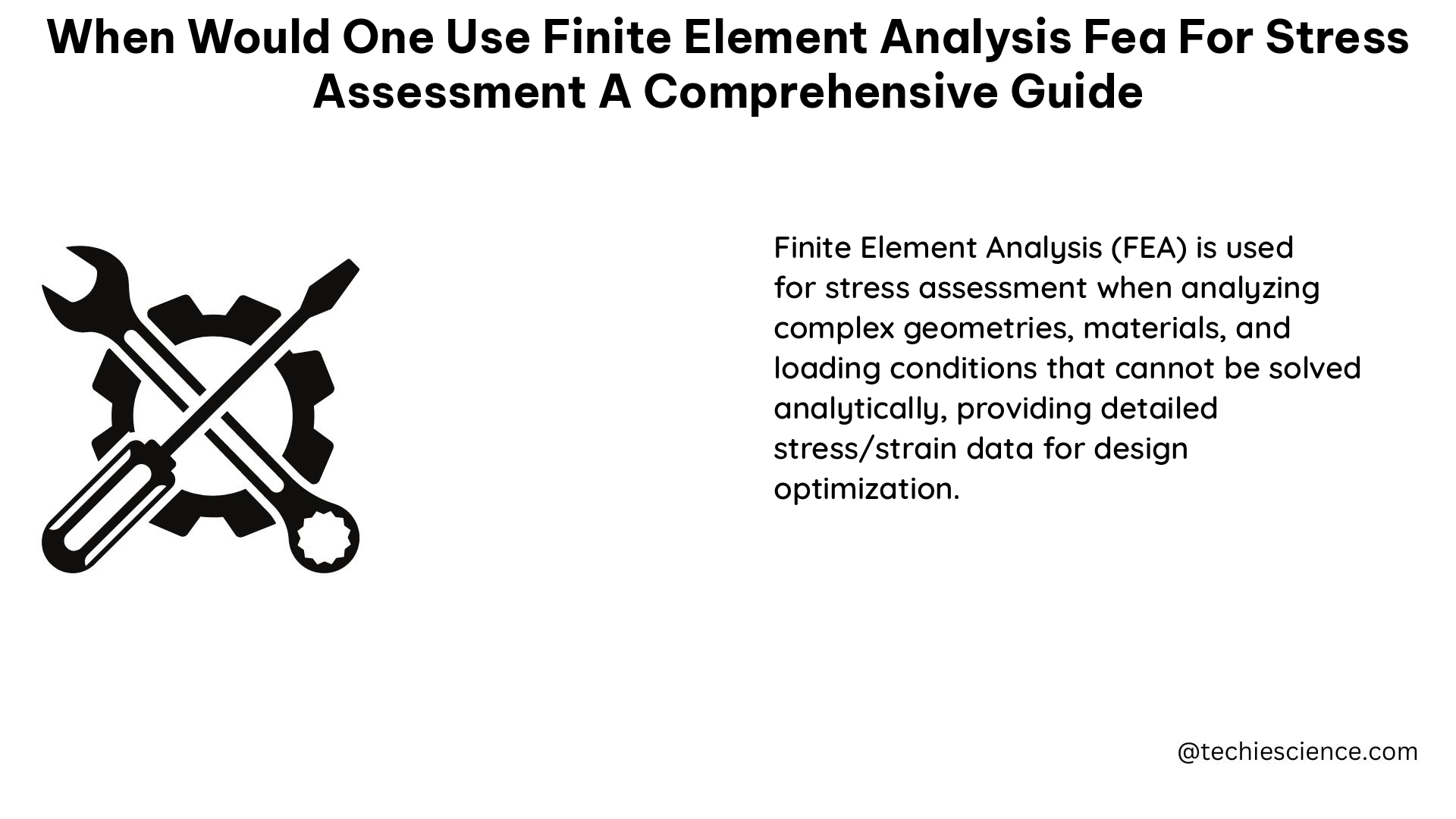Finite Element Analysis (FEA) is a powerful numerical technique used to predict the behavior of a body under load and boundary conditions. It is particularly useful when dealing with complex geometries, non-linear material properties, and complex loading conditions where hand calculations become impractical or impossible. FEA is used to simulate a wide range of physical phenomena, including structural or fluid behavior, thermal transport, wave propagation, and the growth of biological cells.
Understanding the Fundamentals of FEA
FEA is based on the division of a larger system into smaller, simpler parts called finite elements. These elements can be in the form of 1D, 2D, or 3D shapes, and they are connected at nodes. The behavior of each element is described by mathematical equations, and the overall behavior of the system is obtained by combining the individual behaviors of all the elements.
The key steps in the FEA process are:
- Partial Differential Equations (PDEs): FEA provides a means to obtain approximate solutions to PDEs, which describe the behavior of physical systems.
- Variational Methods: Techniques such as the Ritz and Galerkin methods are used to find functions that minimize (or maximize) certain quantities.
- Discretization: The domain is divided into finite elements, transforming a PDE from the continuous domain to a set of algebraic equations in the discrete domain.
- Assembly: The individual behaviors of all the elements are combined to represent the entire structure or system.
- Solution Phase: Various numerical techniques are used to solve the assembled equations and determine unknowns, such as displacements at nodes.
When to Use FEA for Stress Assessment

FEA is a versatile tool that can be applied in a wide range of engineering fields, including aerospace, automotive, biomedical, and energy. Here are some common scenarios where FEA is used for stress assessment:
Aerospace Industry
- Aircraft Component Testing: FEA is used to test aircraft components under extreme conditions, ensuring they meet rigorous safety standards without the need for excessive physical prototypes.
- Structural Integrity Analysis: FEA is employed to assess the structural integrity of aircraft structures, such as wings, fuselage, and landing gear, under various loading conditions.
- Aerodynamic Optimization: FEA is used to optimize the aerodynamic design of aircraft components, such as wings and control surfaces, to improve fuel efficiency and performance.
Automotive Industry
- Crash Simulations: FEA is used to simulate vehicle crashes, allowing engineers to assess the safety and structural integrity of the vehicle design.
- Component Design Optimization: FEA is employed to optimize the design of various automotive components, such as suspension systems, engine parts, and body panels, to improve performance and reduce weight.
- Thermal Management: FEA is used to analyze the thermal behavior of automotive components, such as brakes and engine systems, to ensure proper cooling and prevent overheating.
Biomedical Industry
- Tissue and Organ Simulation: FEA is used to simulate the behavior of biological tissues, bones, and organs, aiding in the design of medical implants and prosthetics.
- Implant Design Optimization: FEA is employed to optimize the design of medical implants, such as hip and knee replacements, to ensure proper fit, load distribution, and long-term durability.
- Biomechanical Analysis: FEA is used to analyze the biomechanical behavior of the human body, such as joint movements and muscle forces, to improve the design of rehabilitation devices and sports equipment.
Energy Industry
- Structural Integrity Assessment: FEA is used to assess the structural integrity of energy infrastructure, such as offshore oil platforms, wind turbines, and power plant components, to ensure safety and reliability.
- Thermal and Fluid Analysis: FEA is employed to analyze the thermal and fluid behavior of energy systems, such as heat exchangers, combustion chambers, and cooling systems, to optimize efficiency and performance.
- Renewable Energy Design: FEA is used to optimize the design of renewable energy systems, such as wind turbine blades and solar panel structures, to improve energy generation and withstand environmental loads.
Emerging Trends in FEA for Stress Assessment
The field of FEA is constantly evolving, and recent trends include the development of cloud-native simulation services and tools. These web-based applications run in the browser and utilize remote servers for the computing tasks, freeing up local resources and lowering the requirement for powerful hardware and specialized software installations.
Additionally, advancements in computational power, data storage, and machine learning algorithms have enabled the integration of FEA with other simulation and optimization techniques, such as topology optimization and generative design. These integrated approaches allow for more comprehensive and efficient product development, leading to improved performance, reduced costs, and faster time-to-market.
Conclusion
Finite Element Analysis (FEA) is a powerful numerical technique that is widely used for stress assessment and a variety of other engineering applications. By understanding the fundamental principles of FEA and the specific scenarios where it is most useful, engineers can leverage this tool to optimize their designs, ensure safety, and drive innovation across various industries.
References
- Finite Element Analysis (FEA): The Ultimate Guide. (2023-08-17). Retrieved from https://www.nrp.co.th/post/finite-element-analysis-fea-the-ultimate-guide
- What Is FEA | Finite Element Analysis? (Ultimate Guide). (2023-12-07). Retrieved from https://www.simscale.com/docs/simwiki/fea-finite-element-analysis/what-is-fea-finite-element-analysis/
- FEA For Beginners – Finite Element Analysis | SimScale. (2024-03-14). Retrieved from https://www.simscale.com/blog/fea-for-beginners/
- When do you use Finite Element Analysis (FEA)? : r/AskEngineers. (2021-06-20). Retrieved from https://www.reddit.com/r/AskEngineers/comments/o3t9s0/when_do_you_use_finite_element_analysis_fea/

The lambdageeks.com Core SME Team is a group of experienced subject matter experts from diverse scientific and technical fields including Physics, Chemistry, Technology,Electronics & Electrical Engineering, Automotive, Mechanical Engineering. Our team collaborates to create high-quality, well-researched articles on a wide range of science and technology topics for the lambdageeks.com website.
All Our Senior SME are having more than 7 Years of experience in the respective fields . They are either Working Industry Professionals or assocaited With different Universities. Refer Our Authors Page to get to know About our Core SMEs.